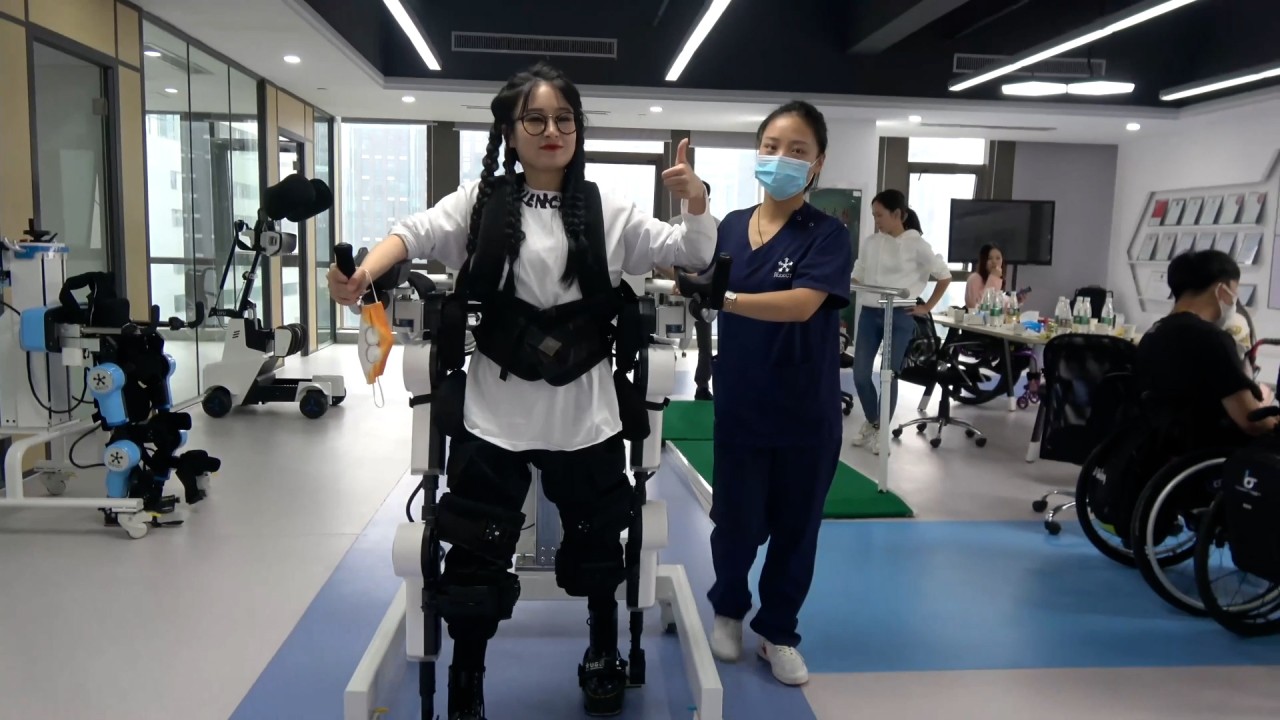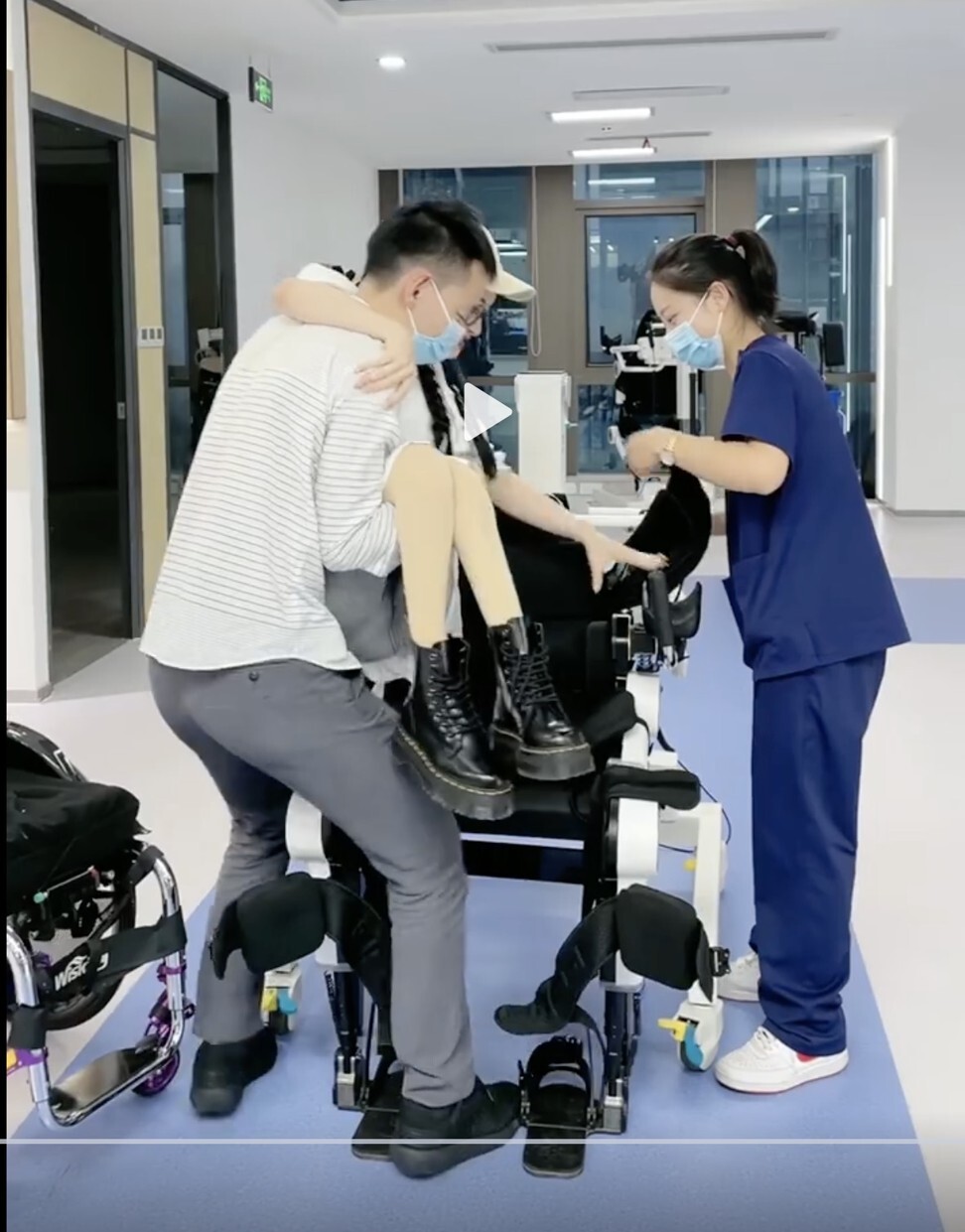
01:14
China’s exoskeleton may be key to helping paralysed patients walk again

For the first time in a dozen years, Duoduo could remember what it felt like to walk.
Her legs were strapped into large modern splints, and a fabric brace supported her waist. Surrounding her was what appeared to be the exoskeleton of robotic legs.
As Duoduo begins to move, her legs follow the familiar path so many of us take for granted.
“I’ve been crying ever since,” she wrote on Weibo. “It is a feeling that I have not had in so long, something I almost forgot. I had almost given up walking, thinking I would spend my days in a wheelchair.”

01:14
China’s exoskeleton may be key to helping paralysed patients walk again
In 2009, when Duoduo was 17 years old, she was playing with some friends on the second floor of a housing complex. She lost her balance and fell onto a pile of sand, landing squarely on her bottom.
She could not move or feel her legs.
Duoduo told the South China Morning Post that she did not fully grasp the severity of her injury because she had never met anyone with spinal injuries before.
“After a few years of exercises, I still did not improve, that is when I realised I would not get better. There were nights where I bawled into my blanket,” she said.
Last month, Duoduo received a call from RoboCT Technological Development Company, a start-up founded in 2017 based in Hangzhou, the capital of the eastern province of Zhejiang. The company is focused on robotics, rehabilitation medicine and artificial intelligence.
They wanted her to try their exoskeleton technology.
Even though it appears like something out of the Ironman films, the exoskeleton is finding a niche in everyday life, such as helping people lift heavy objects and supporting medical rehabilitation.
It is unclear if the technology will break out of specific use cases, as it is expensive and does not fit naturally into day-to-day life.
Zhang Jiyu, the RobotCT operations director, told the Post they chose to focus on the medical field because of the obvious value the exoskeleton can add.
“When a person rehabilitates, the first step he takes and the 100,000th step are different,” Zhang said. “When using the equipment, every step can be adjusted, one step can be 35 centimetres in length and the next step can be 42 centimetres, it has to be combined with the person’s intention.”
The equipment, which received licensing from China’s National Medical Products Administration in 2019, uses sensors integrated with artificial intelligence to adjust the walking movement to fit the user. It gives the user the sensation of walking, rather than simply feeling like their legs are being dragged.
Duoduo said, in the past, it would require three or four people to help her move her limbs.
“Machines made the rehabilitation process easier and more suitable on a large scale,” she said.

Currently, traditional rehabilitation employs therapeutic exercises to enhance peripheral nerve regeneration or improve functional recovery. They rely heavily on therapists to move the limbs to fight muscle degeneration and, in best-case scenarios, help the person recover some function in the affected limbs.
But not everyone can afford to go to rehabilitation centres every day, and exercises done at home are usually not up to par, Duoduo said.
Despite the moment of glee when she first tried the exoskeleton, Duoduo wants to temper her expectations, saying: “When you have lived in a wheelchair for a long time, you slowly get used to life with the chair. You don’t have high hopes about being able to walk again because it is exhausting to keep having expectations that never come to pass.”
But regardless of her medical status, Duoduo has inspired thousands and sparked hope across China.
Thousands of people flocked to her Weibo page, seeking help for their paralysed relatives. They called her “Metal Warrior Beauty”, praising her warm smile and positive attitude.
As far back as 1990, futurist Ray Kurzweil, Google’s current Director of Engineering, predicted that bionic exoskeletons would help paraplegics walk by the early 2000s.
While his prediction has not become mainstream, there are a handful of robotics products in the rehabilitation field, such as the Lolomat from Switzerland’s Hocoma Company, Ekso from Ekso Bionics in the US and HAL from Japan’s Cyberdyne.
In China, the technology is still in its early stage of development. RoboCT is on the forefront of the industry in China, and it has cooperated with close to 200 hospitals. Their products have been used over 80,000 times.

Shanghai-based Fourier Intelligence and Shenzhen-based Milebot have also developed similar walking technologies.
Zhang, from RoboCT, said the long-term goal is to bring the exoskeletons out of rehab centres and into everyday life.
But he said it will be years before that goal is reached, and there are still significant barriers to more widespread adoption – including its feasibility outside a contained environment.
One student studying mechanics wrote on Weibo: “The equipment is still too large for everyday use. I hope we can turn everyone into an Ironman in the future.”
The exoskeletons are also expensive. One unit costs more than 100,000 yuan (US$15,600). By comparison, a high-quality wheelchair that a paraplegic might spend significant time in costs around 2,000 yuan (US$312).
However, the early stages of the technology are still exciting.
Duoduo’s family has two elderly members who have hemiplegia, a disease caused by brain injury that leads to muscle weakness. The exoskeleton could prove practical to help them regain their strength.
“The times I live in have given me much hope,” Duoduo wrote on Weibo.